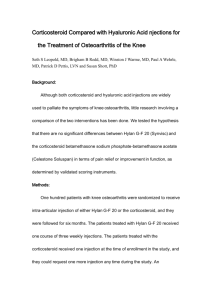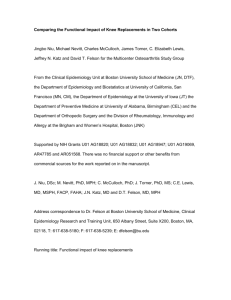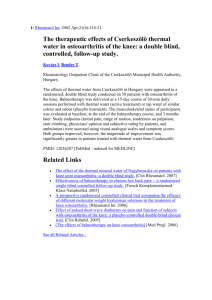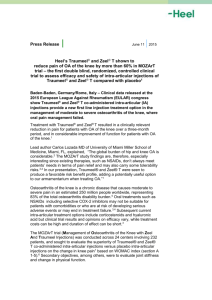DOTTORATO DI RICERCA IN MEDICINA FISICA E RIABILITATIVA
advertisement
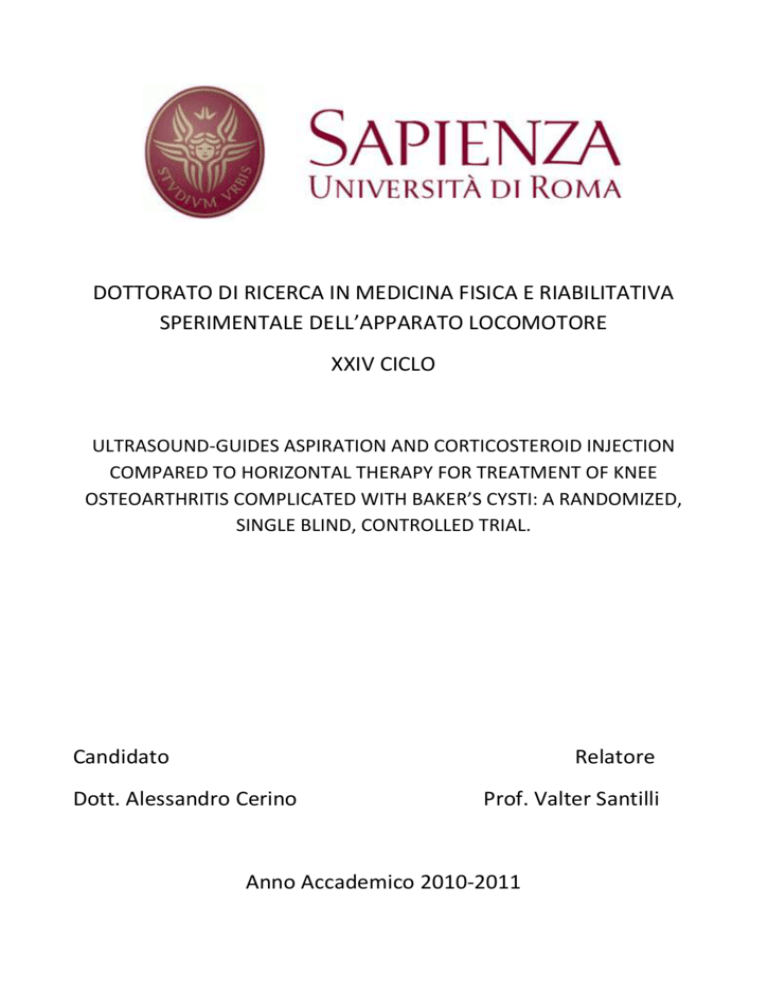
DOTTORATO DI RICERCA IN MEDICINA FISICA E RIABILITATIVA SPERIMENTALE DELL’APPARATO LOCOMOTORE XXIV CICLO ULTRASOUND-GUIDES ASPIRATION AND CORTICOSTEROID INJECTION COMPARED TO HORIZONTAL THERAPY FOR TREATMENT OF KNEE OSTEOARTHRITIS COMPLICATED WITH BAKER’S CYSTI: A RANDOMIZED, SINGLE BLIND, CONTROLLED TRIAL. Candidato Relatore Dott. Alessandro Cerino Prof. Valter Santilli Anno Accademico 2010-2011 Introduction BC is a fluid distension of a bursa between the gastrocnemius and semimembranosus tendons that fills an anatomical communication with the knee joint1. It can be classified anatomically and clinically as a primary or, more frequently, as a secondary cyst. Several authors have reported that 41% to 83% of joint disorders have associated popliteal secondary cysts2. Meniscal tears, and degenerative joint disease, infectious arthritis, polyarthritis, villonodular synovitis and some connective tissue diseases are pathologies commonly associated with BC3. Therapy for BC depends on the primary cause, but intra-articular corticosteroid injection or a direct puncture of the cyst for aspiration and corticosteroid administration are widespread practices.4,5,6 Physical therapy agents, e.g. transcutaneous electrical nerve stimulation (TENS), interferential therapy (IFT) or percutaneous electrical nerve stimulation, play an important role in the treatment of knee OA7,8. Deep heat such 2 as short waves and electrotherapeutic modalities such as interferential therapy (IFT) are used for the treatment of acute and chronic pain, which are the cardinal symptoms of OA9,10. Horizontal therapy (HT) is a novel analgesic therapy that is expected to extend the advantages of traditional IFT. HT envisions that the intensity of the electricity is constant, whereas the frequency of the electric impulse is modified during application. HT has been found to be effective in treating lower back pain in patients suffering from osteoporosis11. No studies exist concerning the effectiveness of electrical nerve stimulation in patients having knee OA complicated with BC. To the best of our knowledge, electrical therapies play a role in pain relief and improvement of function. Nevertheless, little known about the possibilities of using physical therapies in complicated knee OA. Furthermore, combining different therapies, i.e. pharmacological and physical therapies, generally produces better outcomes for symptoms of knee OA than do isolated therapies12. We therefore propose that better outcomes may be obtained also in 3 knee OA complicated by BC, when a multi-model therapeutic approach rather than a single therapy is applied. We designed a RCO in order to assess if HT and aspiration alone or in combination determine pain relief and functional improvement in a group of patients with knee OA complicated by BC. Methods Consecutive patients of both sexes attending our outpatient clinic between June 2009 and September 2010 with a knee OA and a clinical suspicion of BC were initially enrolled in the study. Clinical and radiographic criteria of the American College of Rheumatology for knee OA13 were used to detect knee OA. To be included, diagnosis of BC should be confirmed by means of standard US evaluation and BC should be symptomatic, i.e. patients have to refer pain in the posterior aspect of the knee at rest or during activity and when physical examination showed painful swelling at palpation of the posterior aspect of the knee 4 and/or tension in the popliteal fossa limiting flexion-extension to a variable degree. Patients were excluded if they presented one of the following: a score K III of Kellgren and Lawrence grading scale13, knee joint instability; previous open or arthroscopic knee surgery; history of systemic or local infectious, neoplastic and/or rheumatic diseases and subject with pace-maker. The procedure followed was in accordance with the ethical standards of our institution. Study design The trial was conducted as a single blind, randomized, controlled trial. After obtaining written informed consent from all the subjects, a clinical and instrumental evaluation was performed at the baseline (T0) to evaluate inclusion and exclusion criteria. Patients who satisfied the inclusion criteria were randomized to either the US-guided BC aspiration and corticosteroid injection group (Group A), the Horizontal Therapy group (Group B) or the 5 US-guided BC aspiration and corticosteroid injection plus Horizontal therapy group (Group C) using a computer-generated 1:1:1 allocation sequence. All patients in the three groups underwent clinical and US evaluation at baseline, at the end of the treatment (T1) and at 1-month follow-up (T2) (figure 1 Flowchart). As a primary outcome measure we considered pain reduction as measured by visual analog scale (VAS) and by Western Ontario and McMaster Universities (WOMAC) pain subscale. As secondary outcome measures we considered functional improvement, as measured by WOMAC joint stiffness and disability subscales and reduction of maximal axial and sagittal areas of the BC, as assessed by means of US. Any adverse event was also registered during the follow-up period. US Evaluation US evaluation was performed in all patients at each follow-up by the same experienced physician, using a 7.5-MHz linear-array transducer (GE Healthcare, Logiq P5 pro, Japan). Both sagittal 6 and transverse scans of the popliteal fossa were performed, and the maximal area of the BC in both directions was calculated using the built-in software. Clinical Evaluation A 10-cm VAS with 0 cm labeled “no pain” and 10 cm labeled “the worst pain I have ever had” was used to assess pain. The patient placed a mark somewhere along a line in response to the question, “With respect to the worst pain you have experienced in your life, what has been the relative level of your knee pain in the last 24 hours?” The Italian version of the WOMAC OA index15, a self-assessment multi-dimensional instrument that evaluates 17 functional activities, 5 pain-related activities, and 2 joint stiffness categories in three different subscales, was used to measure dysfunction and pain. US-guided BC aspiration and corticosteroid injection. US-guided aspiration and corticosteroid injection into the BC were performed by means of a free-hand technique.11 7 With the patient lying prone, a scan of the popliteal region was obtained. The BC was localized and then, under aseptic conditions, all patients received an injection through a posteriormedial approach at the level of the joint line, by means of a 22 gauge needle with drawing of serous fluid, until the cyst was completely decompressed, followed by injection of 40 mg methylprednisolone acetate and lidocaine hydrochloride. Horizontal Therapy Horizontal therapy was delivered through a specific commercial device (PRO ElecDT 2000, Hako med; D). As regards the location of the electrical pads, we strictly followed the instructions provided by the manufacturers of the instruments. Therapy consisted of the placement of 4 cutaneous electrodal pads (8×13 cm), one in center of the popliteal, one on the patella and two others at the posterior proximal site of the thighs, with a stimulation frequency oscillating at 100 Hz between 4400 and 12346 Hz for 30 minutes. Each patient underwent 10 treatments (5 8 per week), each lasting 30 minutes. The first 10 minutes of treatment consisted of a progressive increase in frequency according to a logarithmic scale and a subsequent decrease with frequencies between 4357 and 12346 Hz (DISCAN); the following 10 minutes of treatment consisted in gradual increase in frequencies and subsequent decrease between 1 and 100 Hz; the last 10 minutes of treatment consisted in a fixed frequency to 4357 Hz. In patients of Group C, a complete cycle of HT was started three days after US-guided aspiration and corticosteroid injection into the BC. Sample Size Based on the results of a previous study 5, 16 the target sample size of 60 (20 in each group) was calculated to ensure at least 90% power to detect a difference of 1.7 points with 1.3 points of standard deviation in change of VAS scores between the treatment groups using two-side O=0.01, and anticipating that protocol violators and early discontinuations would amount to 20%. 9 Statistical Analysis Statistical analyses were carried out using the SPSS version 18 package (SPSS Inc, Chicago, Ill). All primary and secondary outcome analyses were performed according to the principle of intention-to-treat. The one-way analysis of variance (ANOVA) or the Kruskal-Wallis test were used, as appropriate, to detect differences among groups as regards baseline demographic and clinical characteristics. The choice of parametric or nonparametric tests was dictated by the results of a normality test. A 2-way ANOVA with group as the between-subjects factor and time as the within-subjects factor was used to detect any significant differences between the three groups and within each group before and after treatment and at 1-month follow-up. A Tukey post hoc comparison was used to detect any significant differences between the mean values when a significant main effect and interaction were found. The level of significance was set at P < 0.01 for all analyses. 10 Results A total of 60 patients were randomized into group A (n = 20), group B (n = 20) or Group C (n = 20) (Figure 1 flowchart). The demographic and clinical baseline characteristics of the 3 groups were well balanced (Table 1). As regards primary outcome measures, 2-way ANOVA showed a significant group (F=19.521; p<0.001) and time (F=66.129; p<0.001) effect for VAS score while no significant group*time interaction was found (F=2.708; p=0.03). Post hoc analysis revealed that VAS scores were significantly lower than baseline values at the end of the therapy. At this time, however, patients in group C displayed the best results when compared with other groups. Patients in group A and in group C, but not those in group B maintained lower pain level at T2 than at baseline, with significant lower VAS values in Group C (Table 2). Two-way ANOVA showed a significant group (F=14.854; p<0.001) and time (F=47.262; p<0.001) effect for Womac pain 11 subscale while no significant group*time interaction was found (F=1.687; p=0.155). Post hoc analysis revealed that WOMAC pain scores were significantly lower than baseline values at the end of the therapy. At this time, however, patients in group C displays the best results when compared with other groups. Patients in all groups maintained lower pain level at T2 than at baseline, with significant lower VAS values in Group C when compared with Groups A and B (Table 2). Regarding WOMAC joint stiffness scores, 2-way ANOVA showed a significant group (F=8.521; p<0.001) and time (F=13.344; p<0.001) effect for VAS score while no significant group*time interaction was found (F=1.777; p=0.136). Post hoc analysis revealed that WOMAC joint stiffness scores were significantly lower than baseline values at the end of the therapy and at 1-month follow-up in group B and C, but not in group A (Table 2). A significant group (F=19.325; p<0.001) and time (F=17.725; p<0.001), but not group*time interaction (F=1.961; 12 p=0.103) effect for WOMAC disability subscore was found. WOMAC disability scores were significantly lower than baseline values at the end of the therapy and at 1-month follow-up in group B and C, but not in group A (Table 2). As regards US measurements, the maximum axial area did not change as a consequence of the treatment in any of the three groups (F=1.334; p=0.259). Contrarily, sagittal area measurements were influenced by time (F=10.027; p<0.01) at 2-way ANOVA. Post hoc analysis revealed significant differences between preand post-treatment evaluation in Group B and Group C, but not in Group A (Table 3). Discussion According to our results HT and aspiration, alone or in combination, are effective in terms of pain relief and functional improvement in a group of patients with knee OA complicated with BC. Interestingly, however, the best results were obtained in those patients in whom the therapies were administered in 13 combination (Group C). This is in line with other work that has shown that the combination of different therapies improve both pain and, consequently, function.16 Pain is an important factor restricting movement and functionality. Theoretically, when pain decreases, muscle spasm decreases and joint mobility and concomitantly function should increase.12,18 The wall surface calculated in both axes was reduced in all cases after injection, but the values in question were not significant. Intra-articular injections of corticosteroids improve symptoms associated with BC by reducing intracavitary pressure and helping to resolve the flare16, although we have seen how the results of the HT are superior about the pain and function at the first week but no in terms of reduce surface of BC. Although the reduction of the areas are not significant, this would seem to reduce the only simple painful swelling in all groups. Therefore, it seems to be more of a mechanical mechanism than merely anti- inflammatory. 14 A recent survey among European specialists demonstrated that, when orthopedic surgeons are faced with BC in adults, only 16% employ aspiration as a first approach, whereas the majority of specialists (37%) tend not to undertake any attempt to cure. The majority of BCs are asymptomatic, but in a small percentage of patients, complications and symptoms occur.19 Cyst aspiration with corticosteroid injection gives pain relief and cyst volume reduction in patients with BCs and concomitant knee osteoarthritis5. However, when compared with current literature, the results are similar to those obtained through intra-articular knee corticosteroid injection16. Therefore, when only a localized painful swelling is present as a secondary complication of BC, we consider it appropriate to perform not aspiration but only corticosteroid injection or else HT. In effect in our case, the only HT was more effective than US-guided aspiration and corticosteroid injection in the BC in terms of both pain and function. The HT is without risk for this aspect and is preferable to 15 the only US-guided aspiration and corticosteroid injection in the BC. There are many more complications of the simple painful swelling which are described in the literature. These may include not only popliteal veins and arteries, but also, in rare cases, cyst leakage and compartment syndrome20,21. Probably the combination therapy should be made when faced with this type of complications in order to reduce the compressive effects caused by Baker’s Cyst. The most important limitation of our trial was the lack of a longterm follow-up; as such, our results are applicable only for the early stage to determine long-term effects on clinical and ultrasound characteristics. Our results show that the group with the best performance has been combined therapy both, pain, function and dimension of BC. However, it should be used only in special cases such as those described above. This is also the case because it remains a minimally invasive therapy and not without risk. 16 References 1)Handy JR: Popliteal cysts in adults: A review. Semin Arthritis Rheum. 2001;31:108–18. 2)Stone KR, Stoller D, De Carli A, et al: The frequency of Baker’s cysts associated with meniscal tears. Am J Sports Med. 1996; 24: 670–671, 3) Rupp S, Seil R, Jochum P, et al: Popliteal cysts in adults. Prevalence, associated intraarticular lesions, and results after arthroscopic treatment. Am J Sports Med. 2002; 30:112-5. 4) Del Cura JL. Ultrasound-guided therapeutic procedures in the musculoskeletal system Curr Probl Diagn Radiol 2008;37:203-18. 5) Di Sante L, Paoloni M, Ioppolo F, et. Al: Ultrasound-Guided Aspiration and Corticosteroid Injection of Baker’s Cysts in Knee Osteoarthritis. Am. J. Phys.Med.Rehabil. 2010; 89:970-975 6) Adler RS, Sofka CM: Percutaneous ultrasoundguided injections in the musculoskeletal system. Ultrasound Q. 2003;19:3–12. 17 7) Rutjes AW, Nüesch E, Sterchi R, Kalichman L, Hendriks E, Osiri M, Brosseau L, Reichenbach S, Jüni P. Transcutaneous electrostimulation for osteoarthritis of the knee. Cochrane Database Syst Rev. 2009; 7:CD002823. 8) Philadelphia Panel. Philadelphia Panel evidence-based clinical practice guidelines on selected rehabilitation interventions for knee pain. Phys Ther. 2001; 81:1675-700. 9) Johnson MI, Tabasam G (2002) A single-blind placebocontrolled investigation into the analgesic effects of interferential currents on experimentally induced ischemic pain in healthy subjects. Clin Physiol Funct Imaging.22:187–196. 10) Cheing GL, Hui-Chan CW. Analgesic effects of transcutaneous electrical nerve stimulation and interferential currents on heat pain in healthy subjects. J Rehabil Med. 2003;35:15-9. 11) Zambito A, Bianchini D, Gatti D, et al. Interferential and horizontal therapies in chronic low back pain due to multiple 18 vertebral fractures: a randomized, double blind, clinical study. Osteoporosis Int. 2007;18:1541-5. 12) Cheing GL, Hui-Chan CW, Chan KM. Does four weeks of TENS and/or isometric exercise produce cumulative reduction of osteoarthritic knee pain? Clin Rehabil. 2002;16:749-60. 13) Altman R, Asch E, Bloch D, et al: Development of criteria for the classification and reporting of osteoarthritis. Classification of osteoarthritis of the knee. Diagnostic and Therapeutic Criteria Committee of the American Rheumatism Association. Arthritis Rheum. 1986;29:1039–49. 14) Kellgren JH, Lawrence JS: Radiological assessment of osteoarthritis. Ann Rheum Dis. 1957;16:494–502. 15) Salaffi F, Leardini G, Canesi B, et al: Gonorthrosis and Quality Of Life Assessment (GOQOLA). Reliability and validity of the Western Ontario and McMaster Universities (WOMAC) Osteoarthritis Index in Italian patients with osteoarthritis of the knee. Osteoarthritis Cartilage. 2003;11:551-60. 19 16) Acebes C, Olga S, Dìaz-Oca A, et al: Ultrasonographic Assessment of Baker’s Cysts after Intra-articular Corticosteroid Injection in Knee Osteoarthritis. J Clin Ultrasound. 2006;34:113-7. 17) Law PP, Cheing GL, Tsui AY Does transcutaneous electrical nerve stimulation improve the physical performance of people with knee osteoarthritis? J Clin Rheumatol. 2004;10:295-9. 18) Cheing GL, Hui-Chan CW. Would the addition of TENS to exercise training produce better physical performance outcomes in people with knee osteoarthritis than either intervention alone?. Clin Rehabil. 2004;18:487-97. 19) Fritschy D, Fasel J, Imbert JC, et al: The popliteal cyst. Knee Surg Sports Traumatol Arthrosc. 2006;14:623-8. 20) Ozgocmen S, Kaya A, Kocakoc E, et al: Rupture of Baker's cyst producing pseudothrombophlebitis in a patient with Reiter's syndrome. Kaohsiung J Med Sci. 2004; 20:600-3. 20 21) Zhang WW, Lukan JK, Dryjski ML: Nonoperative management of lower extremity claudication caused by a Baker's cyst: case report and review of the literature. Vascular. 2005;13:244-7. FIGURE LEGENDS Figure 1: Schematic presentation of patient Flow-chart at one month follow-up Table 1 : Baseline characteristics of the study groups A, B and C before the treatment (T0). Mean of number, age men, VAS, WOMAC scores and areas of BC. Table 2 : Comparison of pain level as measured by visual analog scale and of WOMAC sub-scales scores before and after treatment and at 1-Month follow-up in the three groups. Group A: corticosteroid injection. Group B: Horizontal Therapy. Group C: corticosteroid injection + Horizontal Therapy. P values are in bold when significant. 1: Comparison between before and after 21 treatment within each group. 2: Comparison between after treatment and 1-month follow-up within each group. Table 3 : Comparison of sagittal and axial areas before and after treatment and at 1-Month follow-up in the three groups. Group A: corticosteroid injection. Group B: Horizontal Therapy. Group C: corticosteroid injection + Horizontal Therapy. P values are in bold when significant. 1: Comparison between before and after treatment within each group. 2: Comparison between after treatment and 6-month follow-up within each group. Tab.1 Group 1 Group 2 Group 3 NUMBER 20 20 20 Age men 70,50 (7,6) 70,80 (7,4) 70,50 (8,3) Grade II 11 10 8 Grade III 9 10 12 VAS baseline 6,23(1,3) 6,89(1,1) 6,09(1,5) WOMAC A baseline 5,15(2,7) 5,39(1,7) 4,97(0,9) WOMAC B 4,44(2,1) 5,05(1,8) 4,25(2,2) WOMAC C 5,15(2,7) 6,33(1,5) 4,47(2,2) Sagital 5,07(1,9) 6,52(1,9) 5,01(1,8) Axial 1,90(1,0) 1,68(1,3) 1,67(0,8) Kellgren– Lawrence Area: 22 Tab. 2 Pain (range 0-10) Before treatment After treatment p1 Follow-up P2 WOMAC A Before treatment After treatment p1 Follow-up P2 WOMAC B Before treatment After treatment p1 Follow-up P2 WOMAC C Before treatment After treatment p1 Follow-up P2 Group A Group B Group C A vs B B vs C A vs C 6.23 (1.3) 4.13 (1.5) <0.00001 4.09 (1.3) 0.99 6.89 (1.1) 4.17 (1.6) <0.00001 5.41 (1.3) 0.01 6.09 (1.5) 2.7 (1.5) <0.00001 2.95 (1.3) 0.84 0.29 0.99 0.95 0.003 0.17 0.004 0.009 0,000 0.003 5.15 (2.7) 3.82 (1.1) 0.0009 3.79 (1.5) 0.99 5.39 (1.7) 3.07 (1.8) 0.0000 3.74 (1.7) 0.31 4.97 (0.9) 2.02 (1.5) 0.0000 2.02 (1.4) 1.0 0.95 0.24 0.63 0.06 0.44 0.0005 0.99 0.0008 0.0006 4.44 (2.1) 4.05 (2.5) 0.79 3.74 (2.0) 0.85 5.05 (1.8) 3.01 (1.6) 0.002 3.63 (1.7) 0.83 4.25 (2.2) 1.89 (1.0) 0.0002 2.27 (0.8) 0.79 0.54 0.17 0.35 0.13 0.95 0.0009 0.98 0.05 0.03 5.15 (2.7) 4.11 (2.3) 0.21 4.80 (1.5) 0.50 6.33 (1.5) 3.5 (2.2) 0.0001 4.92 (2.4) 0.06 4.47 (2.2) 2.02 (1.6) 0.0004 2.14 (1.2) 0.98 0.15 0.59 0.01 0.04 0.52 0.003 0.98 0.0001 0.0001 Group A Group B Group C A vs B B vs C A vs C 5.07 (1.9) 3.87 (1.1) 0.30 3.44 (2.1) 0.86 6.52 (1.9) 3.96 (2.6) 0.005 4.48 (2.4) 0.79 5.01 (1.8) 3.04 (2.3) 0.04 3.65 (4.3) 0.73 0.17 0.99 0.15 0.49 0.99 0.56 0.41 0.56 0.96 1.9 (1.0) 1.51 (0.9) 0.59 1.11 (0.7) 0.58 1.68 (1.3) 1.55 (1.0) 0.83 1.87 (1.1) 0.71 1.67 (0.8) 1.14 (1.1) 0.39 1.71 (2.5) 0.33 0.12 0.99 0.89 0.56 0.84 0.63 0.14 0.92 0.29 Tab. 3 Sagittal Area Before treatment After treatment p1 Follow-up P2 Axial Area Before treatment After treatment p1 Follow-up P2 23 Figure : Flow-chart diagram of the study. Assessment for elegibility (n=70) Refuse to participate (n=3) T0: clinical and US evaluation (n=67) Not meeting inclusion criteria (n=7) Randomization (n=60) Group A Allocated (n=20) Received to intervention (n=20) Group B Allocated (n=20) Received to intervention (n=20) Group C Allocated (n=20) Received to intervention (n=20) T1: analyzed (n=20) T1: analyzed (n=20) T1: analyzed (n=20) T2: analyzed (n=20) T2: analyzed (n=20) T2: analyzed (n=20) 24 Index Introduction………………………………….....2 Methods………………………………….……..4 Study design………………………………………...5 US Evaluation………………………………………6 Clinical Evaluation…………………………………7 Statistical Analysis………………………...………10 Results……………………………………………...11 Discussion………………………………………….13 References…………………………………………17 25
